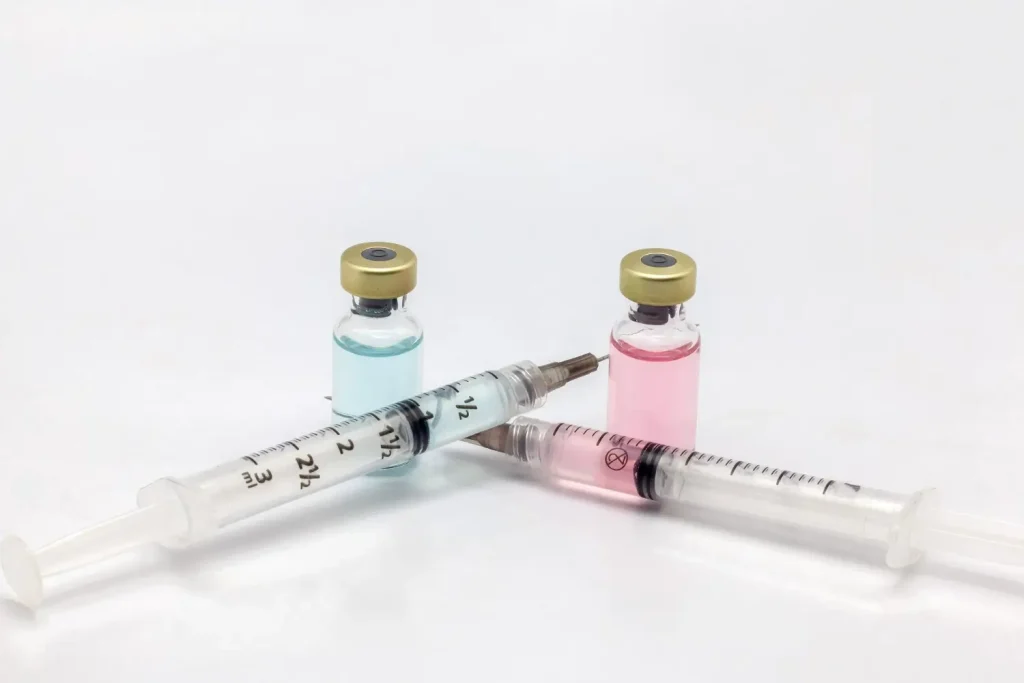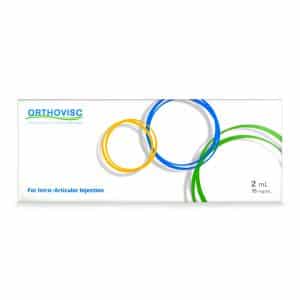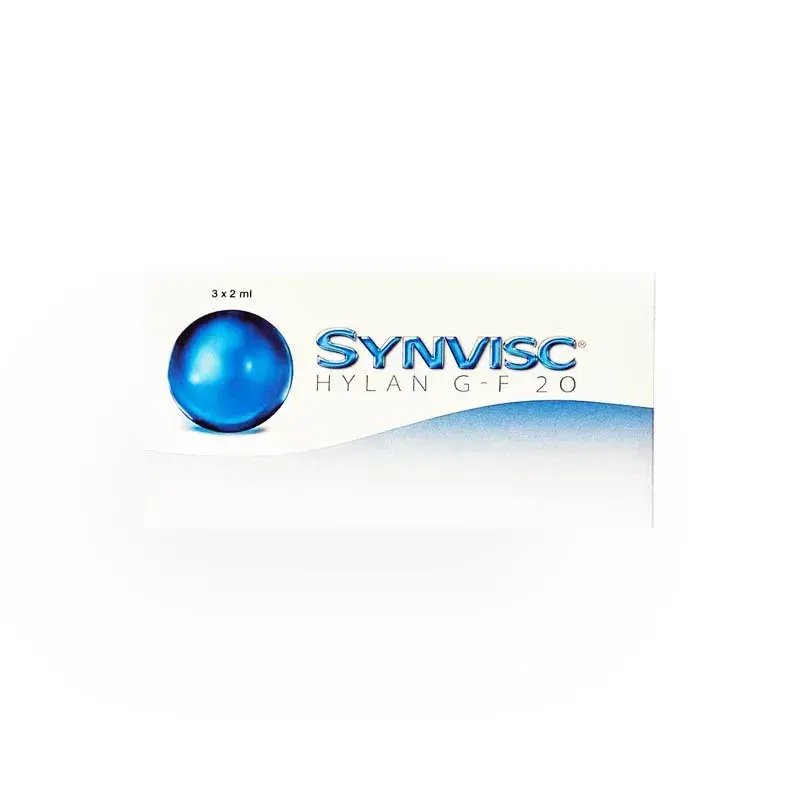When knee osteoarthritis starts to limit daily movement, many patients look for relief beyond exercise, weight control, or oral medication. One popular option is viscosupplementation, which is a treatment that involves injecting hyaluronic acid into the joint to restore lubrication and cushioning. Research shows that these injections can offer moderate pain relief and better mobility for several months, helping some patients delay the need for surgery.
Two of the most widely used products in this category are Orthovisc and Synvisc. Both are designed to mimic the body’s natural synovial fluid, but they differ in important ways, including how they’re made, their molecular structure, and the number of injections required. These distinctions can influence everything from treatment comfort to effectiveness and safety.
This article provides a clear comparison of Orthovisc vs Synvisc, exploring their composition, dosing schedules, clinical results, cost considerations, and allergy risks. We aim to help both patients and healthcare providers make informed, confident treatment choices.
Key Takeaways
- Orthovisc and Synvisc are both hyaluronic acid–based injections used to relieve knee osteoarthritis pain by restoring joint lubrication and improving movement.
- The main difference in source: Orthovisc is made from bacterial fermentation (non-animal origin), while Synvisc is avian-derived from rooster combs.
- Molecular structure matters — Synvisc’s higher molecular weight may extend its presence in the joint, but can increase the chance of injection-site reactions.
- Orthovisc’s non-animal formulation makes it safer for patients with allergies to poultry or avian proteins.
- Injection schedules differ: Orthovisc is given in three weekly doses, while Synvisc-One delivers relief through a single 6 mL injection.
- Both products offer comparable effectiveness, typically providing pain relief for up to six months, although results vary between patients.
About: Medical Spa RX provides medical practices with premium products at the best prices. If you’re looking to buy Orthovisc online for your practice, the sales representatives at Medical Spa RX can give you guidance.
Source and Composition of Orthovisc Compared to Synvisc
Orthovisc and Synvisc are both hyaluronic acid–based injections designed to relieve the pain and stiffness of knee osteoarthritis, but their source, formulation, and molecular weight differ in ways that can affect how patients tolerate and respond to treatment.
Orthovisc

- Source: Produced through bacterial fermentation (non-animal origin).
- Composition: 1% sodium hyaluronate solution.
- Molecular Weight: 1.0–2.9 million Daltons.
Synvisc
- Source: Avian origin (derived from rooster combs).
- Composition: Blend of hylan A (soluble) and hylan B (insoluble) polymers.
- Molecular Weight: Approximately 6 million Daltons.
Because Synvisc has a higher molecular weight and a cross-linked structure, it may remain in the joint longer, but this can also increase the chance of injection-site reactions. Orthovisc’s non-animal origin eliminates exposure to avian proteins, which is safer for patients with poultry allergies.
While both are FDA-approved viscosupplements, these formulation differences help physicians determine which treatment best matches each patient’s health profile.
Injection Regimens: Orthovisc Series vs Synvisc-One
The injection schedule is a defining difference between Orthovisc and Synvisc-One, shaping both the treatment experience and patient convenience. The number of injections, time between visits, and total treatment volume all influence comfort, cost, and compliance.
Orthovisc
- Administered as a series of three intra-articular injections.
- Each dose: 2 mL of 15 mg/mL sodium hyaluronate.
- Injections are spaced one week apart.
Synvisc-One
- A single 6 mL injection of hylan G-F 20.
- Intended to provide up to six months of symptom relief.
Synvisc (standard version) also exists as a three-dose regimen, while Synvisc-One condenses the therapy into a single visit. Orthovisc’s multi-dose schedule allows for gradual improvement and closer monitoring over several weeks, while Synvisc-One appeals to patients seeking one-time convenience, especially those with mobility or scheduling constraints. Although Synvisc-One may have a higher upfront cost, the reduced number of visits can offset overall expenses.
Physicians generally choose between the two based on patient preference, insurance coverage, and previous response to viscosupplementation treatments, such as Orthovisc vs Euflexxa comparisons made in similar cases.
Efficacy and Patient Outcomes With Orthovisc vs Synvisc
Both Orthovisc and Synvisc have shown consistent ability to reduce knee pain and improve joint function, though results can vary between patients. Official guidelines from organizations such as the AAOS, OARSI, and BMJ describe the benefits of viscosupplementation as modest and variable, but many patients experience meaningful improvement that supports activity and delays the need for surgery.
Clinical Outcomes With Orthovisc

- Significant pain reduction sustained over 6 months
- Improved joint mobility and function
- Lower incidence of adverse reactions due to non-animal origin
Clinical Outcomes With Synvisc / Synvisc-One
- Comparable pain relief, with some reports of longer-lasting effects
- Slightly higher rate of post-injection swelling or inflammation
- High patient satisfaction with single-dose convenience
Overall, neither product shows consistent superiority in head-to-head trials. Treatment success depends on individual tolerance, lifestyle factors, and allergy risk. Most clinicians tailor therapy to match the patient’s unique joint health and prior response to viscosupplements.
Cost, Safety, and Allergy Considerations Between Orthovisc and Synvisc
Both Orthovisc and Synvisc provide non-surgical relief from knee osteoarthritis, but their costs, safety profiles, and allergy considerations differ slightly—factors that can influence which treatment is most appropriate for each patient.
Cost Considerations
- Orthovisc typically involves three injections, resulting in a slightly higher total procedure cost but lower cost per dose.
- Synvisc-One requires only one injection, leading to a higher upfront cost, though fewer clinic visits may offset overall expenses.
Safety Profile
- Orthovisc has a low rate of post-injection inflammation and joint effusion, likely due to its non-crosslinked, bacterial-based formulation.
- Synvisc may cause temporary swelling or stiffness, especially in patients sensitive to cross-linked hylan polymers.
- Both products maintain a strong safety record, with serious complications being rare.
Allergy Risk
- Orthovisc is non-animal derived, making it a suitable choice for patients with avian protein allergies.
- Synvisc is avian-derived and may pose a risk for those with poultry sensitivities.
Conclusion
Both Orthovisc and Synvisc remain trusted viscosupplementation treatments for managing knee osteoarthritis without surgery. Their effectiveness is comparable, but each offers distinct advantages. Orthovisc provides a non-animal formulation suited for patients with allergy concerns and allows gradual symptom relief through multiple doses. Synvisc-One, meanwhile, offers the convenience of a single injection and sustained pain relief for several months.
The choice ultimately depends on patient history, lifestyle, and clinician recommendation. Understanding the differences in composition, dosing, safety, and cost helps both patients and healthcare providers select the most fitting option for long-term joint comfort and mobility.
FAQs
1. How long does pain relief from Orthovisc typically last?
Most patients experience pain relief for up to six months, though some may notice benefits for a slightly shorter or longer period.
2. How many injections are needed for one course of Orthovisc?
A typical regimen includes three injections given one week apart, though some patients may require four based on physician guidance.
3. Is Orthovisc safe for patients with poultry or egg allergies?
Yes. Since Orthovisc is made using bacterial fermentation, it does not contain animal-derived proteins that may trigger allergic reactions.
4. Can Orthovisc be combined with other osteoarthritis treatments?
Orthovisc can be used in conjunction with treatments such as physical therapy, exercise, and certain pain medications for comprehensive management of osteoarthritis.
5. Who is a good candidate for Orthovisc treatment?
Candidates usually include adults with knee osteoarthritis who have not responded well to conservative treatments like physical therapy or oral medications.
References
Crockett Z, Asikhia O, Rhim HC, Malik GR. Injection-based therapies for knee osteoarthritis: A comprehensive update. Current Physical Medicine and Rehabilitation Reports. 2024;12(3):256-265. doi:10.1007/s40141-024-00458-2
Yoshioka K, Katayama M, Nishiyama T, Harada K, Takeshita S, Kawamata Y. Biocompatibility study of different hyaluronan products for intra-articular treatment of knee osteoarthritis. BMC Musculoskeletal Disorders. 2019;20(1). doi:10.1186/s12891-019-2815-6
Orthovisc / Viscosupplementation. Integrated Pain Consultants. https://www.azipc.com/content/orthovisc-viscosupplementation























